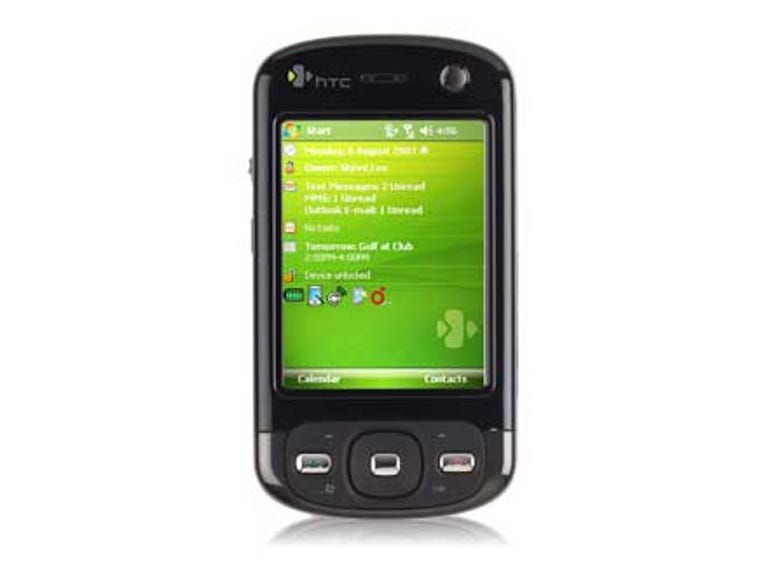 Why You Can Trust CNET
Why You Can Trust CNET HTC P3600i review: HTC P3600i
Decent performance, GPS and good connectivity are a plus for a handset with yesterday's heavy-set PDA aesthetics.
Design
2007 ushered in the inevitable shrinking of smartphone design. PDA-sized handsets have been shunted aside, with BlackBerry's Pearl and HTC's Touch Cruise leading the way with slim, chic profiles. The P3600i is a bit like a dinosaur in this respect, a throwback to yesteryear. Its thick PDA shape and smooth curves seem rubenesque compared to the wafer-thin designs we see more readily these days.
The Good
The Bad
The Bottom Line
When we took the P3600i out of the box we thought, for its size, it must be a slider phone with a hidden keypad, like HTC's TynTN II. It's not a slider however, it's just a hefty little number. This isn't suggesting the P3600i is uncomfortable to hold and use, on the contrary, the handset isn't heavy and it fits in the hand well, but it's not a phone you want to slip in your skinny black jeans before a night out.
The body of the phone is covered in piano-black plastic which soon becomes finger-smeared grey. The P3600i is primarily a touchscreen device, but has a five-way nav button and side-mounted jogwheel to offer alternatives for selection and input. Its 2.8-inch display offers ample screen real estate for using the touchscreen, but didn't seem as bright and vibrant as the newer HTC handsets we've reviewed.
Features
Windows Mobile phones -- if you've seen one, you've seen them all. The P3600 is no exception to this rule, being part of the generation of HTC phones before those which incorporate the "spinning-cube" TouchFlo interface shell. Without the shell, the interface is dull to look at, but practical, giving quick access to messaging and the standard range of WM applications, like Internet Explorer and Microsoft Office document readers.
Like the TyTN II, the P3600i has built-in GPS and comes bundled with CoPilot 7 mapping software. We took the handset out for a test drive and were happy with the results. On average we had a solid GPS signal in about five minutes from start-up and the CoPilot 7 interface is easy to read and navigate with a clear, simple interface and large onscreen buttons. This version of the mapping software also includes turn-by-turn voice guidance.
The P3600i is HSDPA compatible (3.6Mbps) and as such Web browsing and instant messaging is a painless experience. There's also Wi-Fi (802.11 b/g) support, Bluetooth and USB for charging and connecting to ActiveSync on your Windows PC.
Performance
We've seen a range of Windows Mobile PDA phones recently and have seen differences in performance ranging from the blisteringly fast i-mate Ultimate series, to the sluggish, but usable, ASUS M530w. Running on a Samsung 500MHz processor the P3600i falls on the better side of halfway along this same scale.
We did experience some minor lag when applications load, and decreased performance when multi-tasking, probably due to the 64MB of RAM as opposed to the 128MB we have been seeing in the competition.
Using the touchscreen to access the various menu items is smooth and very responsive, however, full touchscreen input is not for everybody, particularly when you need to type a great deal. Punching out long e-mails or using instant messaging is much slower without a keypad, and selecting long strings of characters using the onscreen keyboard and stylus will seriously test your hand-eye coordination. We also found the handset heats up to nearly being uncomfortable to hold, another reason to keep your messages short.
Call quality is good, we didn't notice much in the way of distortion or interference, although we would have liked the internal speaker to be louder as some of our conversations outdoors on busy city streets were difficult to hear.
We found the 2-megapixel camera on the back of the handset produced surprisingly good photos for a PDA-phone. We're not talking 5-megapixel camera-phone quality, and the lack of flash definitely limits its usability, but for pics on a bright, sunny day we saw good colour and sharp focus. This would be perfect for a salesperson to snap off a few quick photos of a property or a used car to MMS to a prospective buyer.
HTC estimate four hours of talk time using 3G services, and 180 hours of standby time. During our tests that included calls, messaging and Web use we enjoyed two days between charges.


